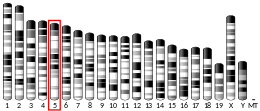EPH receptor A5
EPH receptor A5 (ephrin type-A receptor 5) is a protein that in humans is encoded by the EPHA5 gene.[5][6][7]
This gene belongs to the ephrin receptor subfamily of the protein-tyrosine kinase family. EPH and EPH-related receptors have been implicated in mediating developmental events, particularly in the nervous system. Receptors in the EPH subfamily typically have a single kinase domain and an extracellular region containing a Cys-rich domain and 2 fibronectin type III repeats. The ephrin receptors are divided into 2 groups based on the similarity of their extracellular domain sequences and their affinities for binding ephrin-A and ephrin-B ligands.[7]
References
- GRCh38: Ensembl release 89: ENSG00000145242 - Ensembl, May 2017
- GRCm38: Ensembl release 89: ENSMUSG00000029245 - Ensembl, May 2017
- "Human PubMed Reference:". National Center for Biotechnology Information, U.S. National Library of Medicine.
- "Mouse PubMed Reference:". National Center for Biotechnology Information, U.S. National Library of Medicine.
- Ephnomenclaturecommittee (Sep 1997). "Unified nomenclature for Eph family receptors and their ligands, the ephrins. Eph Nomenclature Committee". Cell. 90 (3): 403–4. doi:10.1016/S0092-8674(00)80500-0. PMID 9267020.
- Spritz RA, Strunk KM, Lee ST, Lu-Kuo JM, Ward DC, Le Paslier D, Altherr MR, Dorman TE, Moir DT (Jan 1995). "A YAC contig spanning a cluster of human type III receptor protein tyrosine kinase genes (PDGFRA-KIT-KDR) in chromosome segment 4q12". Genomics. 22 (2): 431–6. doi:10.1006/geno.1994.1405. PMID 7528718.
- "Entrez Gene: EPHA5 EPH receptor A5".
Further reading
- Zhou R (1997). "Regulation of topographic projection by the Eph family receptor Bsk (EphA5) and its ligands". Cell Tissue Res. 290 (2): 251–9. doi:10.1007/s004410050929. PMID 9321686.
- Caras IW (1997). "A link between axon guidance and axon fasciculation suggested by studies of the tyrosine kinase receptor EphA5/REK7 and its ligand ephrin-A5/AL-1". Cell Tissue Res. 290 (2): 261–4. doi:10.1007/s004410050930. PMID 9321687.
- Flanagan JG, Vanderhaeghen P (1998). "The ephrins and Eph receptors in neural development". Annu. Rev. Neurosci. 21: 309–45. doi:10.1146/annurev.neuro.21.1.309. PMID 9530499.
- Zhou R (1998). "The Eph family receptors and ligands". Pharmacol. Ther. 77 (3): 151–81. doi:10.1016/S0163-7258(97)00112-5. PMID 9576626.
- Holder N, Klein R (1999). "Eph receptors and ephrins: effectors of morphogenesis". Development. 126 (10): 2033–44. PMID 10207129.
- Wilkinson DG (2000). "Eph receptors and ephrins: regulators of guidance and assembly". Int. Rev. Cytol. 196: 177–244. doi:10.1016/S0074-7696(00)96005-4. PMID 10730216.
- Xu Q, Mellitzer G, Wilkinson DG (2001). "Roles of Eph receptors and ephrins in segmental patterning". Philos. Trans. R. Soc. Lond. B Biol. Sci. 355 (1399): 993–1002. doi:10.1098/rstb.2000.0635. PMC 1692797. PMID 11128993.
- Wilkinson DG (2001). "Multiple roles of EPH receptors and ephrins in neural development". Nat. Rev. Neurosci. 2 (3): 155–64. doi:10.1038/35058515. PMID 11256076.
- Fox GM, Holst PL, Chute HT, et al. (1995). "cDNA cloning and tissue distribution of five human EPH-like receptor protein-tyrosine kinases". Oncogene. 10 (5): 897–905. PMID 7898931.
- Davis S, Gale NW, Aldrich TH, et al. (1994). "Ligands for EPH-related receptor tyrosine kinases that require membrane attachment or clustering for activity". Science. 266 (5186): 816–9. doi:10.1126/science.7973638. PMID 7973638.
- Gale NW, Holland SJ, Valenzuela DM, et al. (1996). "Eph receptors and ligands comprise two major specificity subclasses and are reciprocally compartmentalized during embryogenesis". Neuron. 17 (1): 9–19. doi:10.1016/S0896-6273(00)80276-7. PMID 8755474.
- Miescher GC, Taylor V, Olivieri G, et al. (1997). "Extensive splice variation and localization of the EHK-1 receptor tyrosine kinase in adult human brain and glial tumors". Brain Res. Mol. Brain Res. 46 (1–2): 17–24. doi:10.1016/S0169-328X(96)00268-9. PMID 9191074.
- Stein E, Savaskan NE, Ninnemann O, et al. (1999). "A role for the Eph ligand ephrin-A3 in entorhino-hippocampal axon targeting". J. Neurosci. 19 (20): 8885–93. PMID 10516308.
This article is issued from Wikipedia. The text is licensed under Creative Commons - Attribution - Sharealike. Additional terms may apply for the media files.



